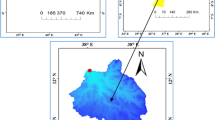Abstract
Quantitative assessment of the stability of slopes is very important for the evaluation of an earth fill dam in order to perform the intended function throughout the service life. This study presents the slope stability and analysis of the Koga earth fill dam. The analyses were carried out using finite element-based PLAXIS 2D software. The behavior of both the body and the foundation of the dam was described using the Mohr–Coulomb criterion. Based on the result of this study, the resulting factor of safety values during end of construction for both static and dynamic stability analysis was 1.6221 and 1.3592, respectively. For steady-state condition, the water level was fixed at normal pool level (2015.25 m). The factor of safety obtained for static stability analysis was 1.6136 and the dynamic analysis 1.3157. The rapid drawdown condition is analyzed with normal pool level of 2015.25 m lowered to 2008.5 m. The analysis results showed that the factor of safety for the static and dynamic analysis was 1.2199 and 1.0353, respectively. Using recommended design standards: United States Army Corps of Engineers, British Dam Society and the Canadian Dam Association the slope stability analysis of the Koga earth dam at all critical loading conditions are safe. The displacement result shows the maximum total displacements for static and dynamic analysis were 1.033% and 1.628% of the dam height, respectively. The displacement result coincides with Fell et al. (J Geotech Geoenviron Eng 129(4):307–314, 2003) standards.





















Similar content being viewed by others
References
Ayele A, Kulhánek O (1997) Spatial and temporal variations of seismicity in the Horn of Africa from 1960 to 1993. Geophys J Int 130(3):805–810
Cheng Z, Jeremić B (2009) Numerical modeling and simulation of soil lateral spreading against piles. In: Contemporary topics in in situ testing, analysis, and reliability of foundations, pp 183–189
DeWolfe GF, Griffiths DV, Huang J (2011) Probabilistic and deterministic slope stability analysis by random finite elements. In: GeoTrends: the progress of geological and geotechnical engineering in Colorado at the Cusp of a New Decade, pp 91–111
Fallah H, Noferesti H (2015) Stability assessment of the Farrokhi earth embankment dam using the pseudo-static and deformation based methods. Int J Min Geo Eng 49(2):205–220
Fell R, Wan CF, Cyganiewicz J, Foster M (2003) Time for development of internal erosion and piping in embankment dams. J Geotech Geoenviron Eng 129(4):307–314
Hasani H, Mamizadeh J, Karimi H (2013) Stability of slope and seepage analysis in earth fills dams using numerical models (case study: Ilam Dam-Iran). World Appl Sci J 21(9):1398–1402
Idriss IM, Duncan JM (1988) Earthquake response analysis of embankment dams. In: Jansen RB (ed) Advanced dam engineering for design, construction, and rehabilitation. Springer, Boston, pp 239–255
Jaroszewicz L, Kurzych A, Krajewski Z, Marć P, Kowalski J, Bobra P, Jankowski R (2016) Review of the usefulness of various rotational seismometers with laboratory results of fibre-optic ones tested for engineering applications. Sensors 16(12):2161
Keir D, Ebinger CJ, Stuart GW, Daly E, Ayele A (2006) Strain accommodation by magmatism and faulting as rifting proceeds to breakup: seismicity of the northern Ethiopian rift. J Geophys Res Solid Earth 111(B5):1–17
Kolbe T, Marçais J, Thomas Z, Abbott BW, de Dreuzy JR, Rousseau-Gueutin P, Pinay G, Pinay G (2016) Coupling 3D groundwater modeling with CFC-based age dating to classify local groundwater circulation in an unconfined crystalline aquifer. J Hydrol 543:31–46
Malekpour A, Zade DF, Dalir AHZ, Sadrekarimi J (2012) Effect of horizontal drain size on the stability of an embankment dam in steady and transient seepage conditions. Turk J Eng Environ Sci 36(2):139–152
Mekonen T, Kebede F (2011) Suitability of Koga Watershed for Irrigated Sugarcane and Onion Production in the Blue Nile Basin, Ethiopia. J Dry Lands 4(2):325–332
Munnoli PM, Bhosle S (2011) Water-holding capacity of earthworms’ vermicompost made of sugar industry waste (press mud) in mono-and polyculture vermireactors. Environmentalist 31(4):394–400
Pelecanos L, Kontoe S, Zdravković L (2020) The effects of dam–reservoir interaction on the nonlinear seismic response of earth dams. J Earthq Eng 24(6):1–23
Pilotti M, Maranzoni A, Tomirotti M, Valerio G (2010) 1923 Gleno dam break: case study and numerical modeling. J Hydraul Eng 137(4):480–492
Powledge GR, Ralston DC, Miller P, Chen YH, Clopper PE, Temple DM (1989) Mechanics of overflow erosion on embankments. I: research activities. J Hydraul Eng 115(8):1040–1055
Seed HB, Lee KL, Idriss IM (1969) Analysis of Sheffield dam failure. J Soil Mech Found Div 95:1453–1490
Sherard JL, Dunnigan LP (1989) Critical filters for impervious soils. J Geotech Eng 115(7):927–947
Suh J, Choi Y, Roh TD, Lee HJ, Park HD (2011) National-scale assessment of landslide susceptibility to rank the vulnerability to failure of rock-cut slopes along expressways in Korea. Environ Earth Sci 63(3):619–632
Tan SA, Tjahyono S, Oo KK (2008) Simplified plane-strain modeling of stone-column reinforced ground. J Geotech Geoenviron Eng 134(2):185–194
Author information
Authors and Affiliations
Corresponding author
Additional information
Publisher's Note
Springer Nature remains neutral with regard to jurisdictional claims in published maps and institutional affiliations.
Rights and permissions
About this article
Cite this article
Zewdu, A. Modeling the slope of embankment dam during static and dynamic stability analysis: a case study of Koga dam, Ethiopia. Model. Earth Syst. Environ. 6, 1963–1979 (2020). https://doi.org/10.1007/s40808-020-00832-8
Received:
Accepted:
Published:
Issue Date:
DOI: https://doi.org/10.1007/s40808-020-00832-8




